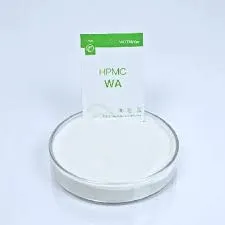
ഒക്ട് . 11, 2024 23:07 Back to list
Is HPMC Soluble in Water for Various Applications and Benefits
Is HPMC Water Soluble?
Hydroxypropyl Methylcellulose (HPMC) is a cellulosic polymer widely used in various industries due to its unique properties and versatility. One of the most critical aspects of HPMC is whether it is water-soluble, which affects its application in pharmaceuticals, food, construction, and other fields.
HPMC exhibits excellent water-soluble characteristics. It is a non-ionic, hydrophilic polymer that readily dissolves in cold water to form a clear, viscous solution. The solubility of HPMC in water is primarily attributed to its chemical structure. The hydroxypropyl and methyl groups attached to the cellulose backbone enhance the polymer's interaction with water molecules. This property makes HPMC valuable in many applications, especially in formulations requiring thickening, binding, or emulsifying agents.
Is HPMC Water Soluble?
In the food sector, HPMC is utilized as a stabilizer, thickener, and emulsifier. It provides a desirable texture to products and is used in sauces, dressings, and bakery items. Additionally, HPMC is particularly appealing to the growing market for gluten-free products, as it can help mimic the structural properties of gluten, enhancing the quality of gluten-free baked goods.
is hpmc water soluble

In construction, HPMC's water-soluble nature contributes to its effectiveness as an additive in cement and mortar formulations. It improves workability, increases adhesion, and reduces water permeability. This versatility makes HPMC a common ingredient in tile adhesives, plaster, and other construction materials, ensuring superior performance and longevity.
When HPMC is incorporated into a formulation, the precise viscosity can be controlled by adjusting the concentration of the polymer as well as the molecular weight. This allows formulators to tailor the properties of the final product according to industry-specific requirements. The ability to create a wide range of viscosities makes HPMC an essential ingredient for manufacturers aiming to achieve specific performance criteria.
Another important feature of HPMC is its resistance to microbial attack, which is especially advantageous in products requiring long shelf life, such as pharmaceuticals and food items. Because it is derived from plant cellulose, HPMC is considered a more natural alternative to synthetic binders and emulsifiers. This is increasingly important in today’s market, where consumers are more conscious of the ingredients in the products they use.
In conclusion, HPMC is indeed water-soluble and offers a variety of beneficial properties that make it suitable for numerous applications across multiple industries. Its unique characteristics, including non-toxicity, biodegradability, and versatility, position HPMC as a vital ingredient in the development of innovative products in pharmaceuticals, food, construction, and beyond. Whether enhancing texture in food products, improving drug release profiles in medications, or contributing to the performance of construction materials, HPMC plays a crucial role in modern manufacturing processes.
-
The Widespread Application of Redispersible Powder in Construction and Building Materials
NewsMay.16,2025
-
The Widespread Application of Hpmc in the Detergent Industry
NewsMay.16,2025
-
The Main Applications of Hydroxyethyl Cellulose in Paints and Coatings
NewsMay.16,2025
-
Mortar Bonding Agent: the Key to Enhancing the Adhesion Between New and Old Mortar Layers and Between Mortar and Different Substrates
NewsMay.16,2025
-
HPMC: Application as a thickener and excipient
NewsMay.16,2025
-
Hec Cellulose Cellulose: Multi functional dispersants and high-efficiency thickeners
NewsMay.16,2025







